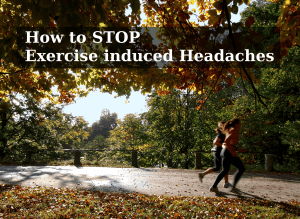End exercise induced headache
It's a vicious circle of the worst kind. You get exercise
induced headache, and yet it's that very exercise that could be the most
effective way to stop your headaches! Some migraineurs are afraid to exercise, afraid that it may bring on the pounding pain that could last for hours or days. People with tension-type headaches try to exercise, but find that the pain only increases. What's the solution?

Why can exercise cause headache?
Exercise induced headache can arrive on your doorstep for a number of reasons. First, it's important to note that it could be a sign of something very serious. If you get an exertion headache for the first time, or it's far worse than ever before, see a doctor right away. She can rule out the more serious causes, and make some suggestions. Check this article for more causes of after exercise headache.
For
most of us, the cause is not serious. The most common exercise headache trigger? Very strenuous exercise. This kind of headache most commonly
effects people in sports like weightlifting.
For migraineurs, it may
just be the shock to your system if you're just starting an exercise
program. Changes will often trigger a migraine. The specific triggers can vary - some blame changes in blood pressure, others low blood sugar or salt levels. Some trial and error can help you stop the pain in most cases.
12 Ways to stop exercise induced headache...
1. Make sure you're warming up before starting and cooling down afterwards.
Try some easier exercise first, or a few minutes of stretching.
Not only can this eliminate exercise induced headache, it also helps
avoid excessive muscle soreness, that could lead to a headache later on (particularly pain in the neck/shoulders).
2. Start your program slowly.
If you're just starting an exercise program, don't start with
something intensive. You may want to try something as simple as a daily
brisk walk, and then move on once your body is used to it. You are
wise to talk to your doctor before starting a new program, especially if
you're over 40 or you have an injury or heart trouble. Also, some programs are specifically designed to be constantly changing. This may not be the program for you.
3. Stay well hydrated. That means, drink water, or alternate between water and a sports drink.
4. Avoid exercise that involved prolonged stooping. In fact, watch your posture in general during exercise, and looks for ways to make improvements (ie a different type of bicycle, a change of sports, simply being more aware of your posture).
5. If you've followed the above suggestions and you're still getting headaches, try taking a couple of NSAIDs before you start, such as ibuprofen (Advil). Talk to your doctor before doing this on a regular basis, as it can cause other problems later on.
6. Try gentler exercise. Lower impact, more stretching. If tennis is causing a problem, try swimming instead, for example.
7. Try taking a drug that constricts blood vessels, such as Ergomar, before you begin (suggestion from Valerie South, RN, of the World Headache Alliance).
8. If dropping blood sugar levels is a problem try taking a glucose tablet before you begin, and then have a starchy snack or better yet a full meal soon after you finish (within an hour)
(from Sue Dyson in Migraines a Natural Approach)
9. Taper off slowly: If you're already involved in intense
exercise, don't stop suddenly. If you know you're going to be taking
some time off, slow down the exercise, don't quit cold turkey.
(Check this article from the Journal of Exercise Physiology for this "reverse" exercise induced headache)
10. Commonly used medication: The International Headache Society writes that Indocin
(an anti-inflammatory medication) is commonly used to treat this type
of headache (primary exertional headache or primary cough headache).
Some patients have also used ergotamine tartrate. Caution should be
exercised when using these medications - talk to your doctor first. Preventative supplements such as regular magnesium may also help.
11. Try a salty snack: Salt tablets are recommended if you're doing very intense exercise in heat. However, for most of us they are going to be too hard on the stomach when a salty snack can do the same thing. Try some tomato juice or a few salty pretzels.
12. Watch your breathing: It's easy to get into bad habits - taking shallow breaths, or not breathing enough. Pay attention to how you're breathing, and aim for slow and deep, exhaling fully.
If you follow these suggestions, and get regular exercise, you should find that the headaches become less and less, and the benefits become greater and greater. Avoiding exercise because of exercise induced headache is a downward spiral. It's time to go onward and upward!
If you haven't yet, check out these suggestions for exercise. A lot of the suggestions on this site come from Dr Mauskop's excellent book, What Your Doctor May NOT Tell You About Migraines.
Also, don't miss this post at Headache and Migraine News, along with the comments: Get a Headache after Working Out?